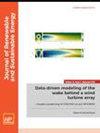通过热解工艺利用稻壳残渣生产燃料的劳动经济评价
IF 1.9
4区 工程技术
Q4 ENERGY & FUELS
引用次数: 0
摘要
目前,一些农用工业废料未经处理,导致温室气体排放量增加。因此,针对化石燃料产生的污染问题,已经推动了对从农用工业和林业残留物中获取燃料的研究。大米是世界上许多家庭的基本产品,其残留物是哥伦比亚具有巨大消费潜力的一种成分。本研究的目的是通过慢速和快速热解工艺,对利用稻壳这种农用工业废料生产燃料进行经济效益评估。利用 Aspen Plus 等模拟器对这两种工艺进行了模拟,并采用了严格的动力学模型。产率值与文献数据进行了验证,得出慢速热解和快速热解的热解油产率分别为 42.3% 和 41.4%。该工艺的总投资成本为 2146.45 千美元。根据模拟器的热力学参数,对两种工艺进行了放能分析。慢速热解和快速热解的总放热率分别为 73.84% 和 78.19%。将经济分析和放能分析结合起来,实施了具体的放能成本计算。慢速和快速热解反应器的放能经济系数分别为 72.21% 和 76.78%。本研究的贡献在于建立了严格的动力学模型,并将其应用于生物质热解过程的能效经济学研究中的慢速热解过程。本文章由计算机程序翻译,如有差异,请以英文原文为准。
Exergoeconomic evaluation of fuel production from rice husk residue through the pyrolysis process
Some agro-industrial wastes are currently untreated, resulting in an increase in greenhouse gas emissions. Therefore, in relation to the pollution generated by fossil fuels, the study of the obtained fuels from agro-industrial and forestry residues has been promoted. Rice is a basic product for several families in the world, and its residue is a component that has enormous potential in Colombia due to its consumption. The objective of the present study is to conduct an exergoeconomic evaluation of the production of fuel from rice husks as agro-industrial waste by means of the slow and fast pyrolysis process. Using simulators like Aspen Plus, the simulation of the two processes was carried up, implementing a rigorous kinetic model. The yield values were validated with data from the literature, obtaining values of 42.3% and 41.4% for slow and fast pyrolysis, respectively, for pyrolytic oil. The total investment cost of the process is 2146.45 kUSD. According to the thermodynamic parameters of the simulator, an exergy analysis was conducted for the two processes. Overall exergy percentages of 73.84% and 78.19% were obtained for the slow and fast pyrolysis, respectively. The economic and exergy analysis was coupled to implement a specific exergy costing. The exergoeconomics factors obtained values of 72.21% and 76.78%, for the slow and fast pyrolysis reactors, respectively. The contribution of the present research is related to the rigorous kinetic model, in addition to its implementation in slow pyrolysis, involved in the exergoeconomic study of biomass pyrolysis processes.
求助全文
通过发布文献求助,成功后即可免费获取论文全文。
去求助
来源期刊

Journal of Renewable and Sustainable Energy
ENERGY & FUELS-ENERGY & FUELS
CiteScore
4.30
自引率
12.00%
发文量
122
审稿时长
4.2 months
期刊介绍:
The Journal of Renewable and Sustainable Energy (JRSE) is an interdisciplinary, peer-reviewed journal covering all areas of renewable and sustainable energy relevant to the physical science and engineering communities. The interdisciplinary approach of the publication ensures that the editors draw from researchers worldwide in a diverse range of fields.
Topics covered include:
Renewable energy economics and policy
Renewable energy resource assessment
Solar energy: photovoltaics, solar thermal energy, solar energy for fuels
Wind energy: wind farms, rotors and blades, on- and offshore wind conditions, aerodynamics, fluid dynamics
Bioenergy: biofuels, biomass conversion, artificial photosynthesis
Distributed energy generation: rooftop PV, distributed fuel cells, distributed wind, micro-hydrogen power generation
Power distribution & systems modeling: power electronics and controls, smart grid
Energy efficient buildings: smart windows, PV, wind, power management
Energy conversion: flexoelectric, piezoelectric, thermoelectric, other technologies
Energy storage: batteries, supercapacitors, hydrogen storage, other fuels
Fuel cells: proton exchange membrane cells, solid oxide cells, hybrid fuel cells, other
Marine and hydroelectric energy: dams, tides, waves, other
Transportation: alternative vehicle technologies, plug-in technologies, other
Geothermal energy
 求助内容:
求助内容: 应助结果提醒方式:
应助结果提醒方式:


